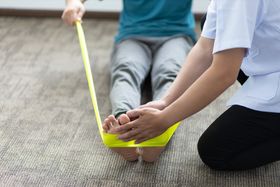Do You Have Shin Splints? Learn How to Test Yourself at Home
Updated December 17, 2024.

Shin splints, also known as medial tibial stress syndrome, is a common overuse-related injury causing pain along the inner border of the tibia bone. This condition is a leading cause of lower leg pain in young competitive athletes worldwide, affecting 35% of the athletic population.
Shin splints occur when the muscles and tissues surrounding the tibia bone become inflamed due to repetitive use. Factors contributing to shin splints include increased training duration, improper footwear, and muscle imbalances in the lower leg or foot. Shin splints typically cause pain during and shortly after exercise, which subsides during rest periods.
Here are some ways to determine if you have shin splints and how to manage the condition conservatively.
Test Yourself for Shin Splints
Determining whether you have shin splints is the first step in the healing process. Shin palpation and shin edema tests are commonly used to diagnose shin splints. These tests can be performed at home or by a medical professional as part of a more extensive assessment.
To check for shin splints, perform the following two tests on both legs:
Shin Palpation Test
Squeeze the lower two-thirds of the lower leg, including the shin bone and surrounding muscular tissue, with sufficient pressure. If you experience pain during this test, it may indicate shin splints.
Shin Edema Test
Apply pressure to the painful area along the lower two-thirds of the tib finger. Press down several times, moving up and down the length of the lower two-thirds of the tibia bone. Remove your finger and observe the area for any indentation left behind. If an indentation remains, it suggests the presence of edema (swelling caused by fluid accumulation under the skin), indicating shin splints.
Treating Shin Splints
If the above two tests for shin splints are positive, there is a high possibility that the source of your lower pain is due to shin splints. Consider the following treatment and prevention strategies:
- Rest: Take a break from exercises that involve impact to the tibia bone and tissues, such as running or jumping. Rest is crucial for allowing inflammation to subside and reducing pain. Opt for low-impact exercises like swimming to avoid aggravating symptoms.
- Ice: Apply ice for up to 20 minutes at a time (with a barrier between the ice and skin) to reduce inflammation and swelling. Ice the area several times throughout the day.
- Orthotics: Orthotics provide cushioning, stability, and support to the feet. The additional shock absorption from orthotics, combined with your shoes, reduces stress on the shin bone during physical activity. Custom-made orthotics can also help prevent shin splints.
- Stretches: Perform gentle stretches targeting the lower leg muscles to improve shin splint symptoms and alleviate pain.
- Foam Rolling: Using a foam roller to perform a myofascial release of the muscles and tissues of the lower leg proves to be beneficial in alleviating symptoms and pain while speeding up healing.
- Massage: Apply massage techniques to the lower leg muscles and tissues to stimulate blood flow and promote healing.
Say Goodbye to Shin Splints
Severe shin splints can affect your ability to walk and may worsen without proper treatment. Custom orthotics, however, offer an effective and affordable way to manage shin splints by alleviating stress on the tibia bone, making the choice of the right insoles for shin splints all the more important.
Upstep offers a range of custom orthotics for various sports needs and conditions affecting the feet and lower legs. These orthotics are beneficial for managing and preventing shin splints from exercise. Upstep's custom orthotics are fully personalized and made with high-quality, durable materials by professionals and come with a 120-day money-back guarantee and free shipping.








